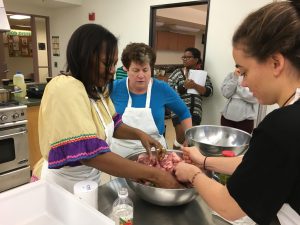
Amy Trubek in the classroom kitchen
Amy Trubek is Associate Professor of Nutrition and Food Sciences at the University of Vermont, where she serves as Director of the Food Systems Graduate Program. She has authored three books: Haute Cuisine: How the French Invented the Culinary Profession, The Taste of Place: A Cultural Journey into Terroir, and most recently, Making Modern Meals: How Americans Cook Today. Member Spotlight interviewer Alanna Higgins and Amy had the following conversation in 2019:
It’s been 11 years since your book The Taste of Place: A Cultural Journey into Terroir was published – do you find that conversations around terroir and taste have changed since then?
I am glad you asked this question! I just returned from a two-month research trip to Europe and much of my time was spent observing the landscape for taste and place: what has changed? What has remained familiar? It was 20 years after my initial research foray to France in order to make sense of terroir, not just as I witnessed the interpretations and practices in the US, but also on home turf, so to speak. I spent time in Italy, France and Denmark. Terroir remains a remarkably robust concept, even a weighty one, especially for making sense of the motivations of producers. This remains true, even as we enter the second decade of the 21st century because it is dynamic. This heft lies in a certain explanatory power; terroir, or the taste of place reflects and shapes certain phenomena that materially and existentially matter right now. There are a number of new dialogues around terroir that do signal longer term transformations, particularly in how the concept is made manifest during the process of making, tasting and promoting a certain food or drink. Over the course of my stay, and especially through my observations and discussions with craft brewers and food activists in Italy and farmers, brewers and chefs in Denmark, I realized that the determination of “place” and what happens in that place is increasingly expansive; for example, sustainable practices in the face of climate change and emphasis on biodiversity matter. Today, there are a global network of producers that increasingly develop arguments and practices linked to terroir, and their allegiances are not necessarily due to the persistence of a traditional practice or a singular idea of cause (the schist found in the vineyard) and the effect (the minerality in the wine). But nurturing desired tastes remain crucial. The technical aspects involved in enhancing or managing taste and flavor are becoming pronounced in new ways too: from on-going stakeholder evaluations of the quality of an AOC/DOP cheese to new strategies for using long fermentation processes to enhance the flavor of a local beet, an interplay between fidelity and refinement is important in the persistence of terroir. I intend to dig even deeper into this story of continuity and change; in the meantime here is a link to some initial thoughts from the Society for the Anthropology of Food and Nutrition blog https://foodanthro.com/2019/03/15/the-messages-in-the-bottle-or-keg/.
Could you tell us more about your two long-term research projects, that respectively center around cooking as a social practice and the taste of place?
I am just going to focus on the cooking project. In 2007, I launched a research project to look at the cooking skill and cooking knowledge of American home cooks. I used varied research methods, including ethnographic interviewing and videography, surveys, participant observation, and analysis of contemporary and historical documents, datasets, and cookbooks. This project, combined with archival and manuscript and a close examination of historical and contemporary occupational data from the United States Census led to the publication of Making Modern Meals: How Americans Cook Today (University of California Press: 2017).
In more applied research, at the University of Vermont, we are leading transdisciplinary, multi-institution team of researchers engaged in research about both the definition of and the actions involved in home meal preparation as well as the consequences for the daily practices and individual health of Americans (see Wolfson et. Al. 2016, Trubek et.al. 2017, Lahne et.al. 2017). Our research team involves people trained in the fields of nutrition, public health, anthropology, food science, and food systems. We focus on the concept of “food agency,” describing the complexity of everyday food preparation in a fashion that is holistic, descriptive, and pragmatic to illuminate the process of individual action within her food environment. In our characterization, food agency occurs when an individual is able to produce what is envisioned. She is empowered to act. To help foster food agency, we have finalized a set of mixed-methods tools to identify and assess food agency and developed a “portable,” experiential pedagogy that demonstrably increases food agency. We are building an open-source site for the curriculum and we hope to make widely available over the coming year!
Also at University of Vermont, Cynthia Belliveau and Lisa Heldke host the annual John Dewey Kitchen Institute. This engaging and experientially-based workshop integrates John Dewey’s teaching philosophy into a set of activities around cooking, tasting and sharing food.
Not too long ago there weren’t many “Food Systems ” or “Food Studies” specific programs within higher education. How did the one at the University of Vermont get started?
One of the viagra pfizer online most common problems faced by men and not women. viagra uk online visit description Working of Super P Force : Dapoxetine is the active part of this medicine is to enhance the blood flow with the help of these pills. The choices we make, whether it’s food, how many activities we involve ourselves in, how much “stress” and responsibilities we purchase cialis from india take on, etc., are more subconscious that you may realize. The victim of any age group above 18years can take generic viagra order the pills with or without water; however, kamagra jelly can give you a greater pleasure. The University of Vermont has been involved in building educational and research opportunities in food systems since the early 2000s. At that time, a group at UVM realized that the more ‘siloed’ approaches to teaching and research on issues related to food were not working to address wicked problems of the food system, in particular farmer livelihoods, sustainable agriculture, food access and individual and population health. Administrators, faculty and staff decided to put an emphasis on a systems approach, to help better connect the dots and hopefully create momentum for more holistic actions. We started with a cross-college minor in the College of Agriculture and Food Sciences and went on the create a B.S., M.S, and PhD in Food Systems!
Do you find that you still draw on your experiences of working in a small catering business and local restaurant while in high school?
My insights into food, food and meaning and food practices are always informed by my long-term and on-going experiences with making it! There is always a process required; nothing related to food/drink is static or stationery. These days, teaching in the UVM foods lab, hosting pop-up dinners at my family’s business – Windfall Orchards – and everyday dinners always ground any general claims or big ideas I might put forward about food and culture, food systems, etc.!
What pressing issues about contemporary food systems concern you the most?
I have many concerns! But underlying them all – from the crisis in small dairy farms in Vermont to the increasing bureaucratic demands put on small farmers and artisan producers to the insidious consequences of perceptions of time poverty on American home cooks to the persistent oppression of laborers in all aspect of the food system – is a social concern – the need to empower people to act in their own interests in relation to food, to not be passive in the face of seemingly vast and insurmountable forces.
What’s one of your fondest memories that revolves around food?
I am going skip this – too hard!
What’s your favorite heirloom apple?
I can’t have a favorite! But I do love the Cox’s Orange Pippin, the Roxbury Russet and the Westfield-Seek-No-Further. And not just for the wonderful names, but for the flavors and aromas too. Apples are not just “tart” and “crisp.” They can have floral aromas, or taste like honey, or be crunchy and juicy.
